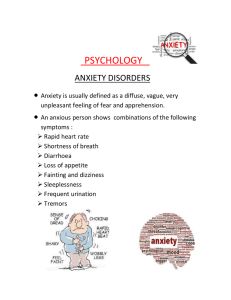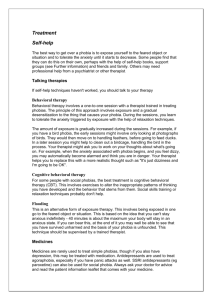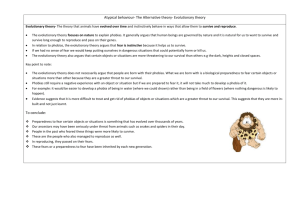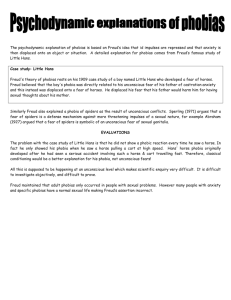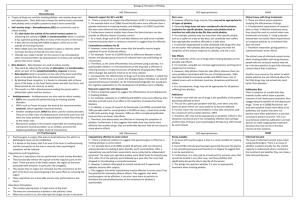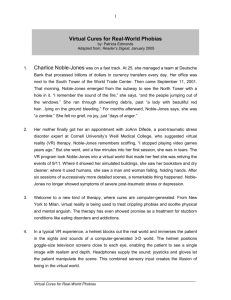- Goldsmiths Research Online
advertisement
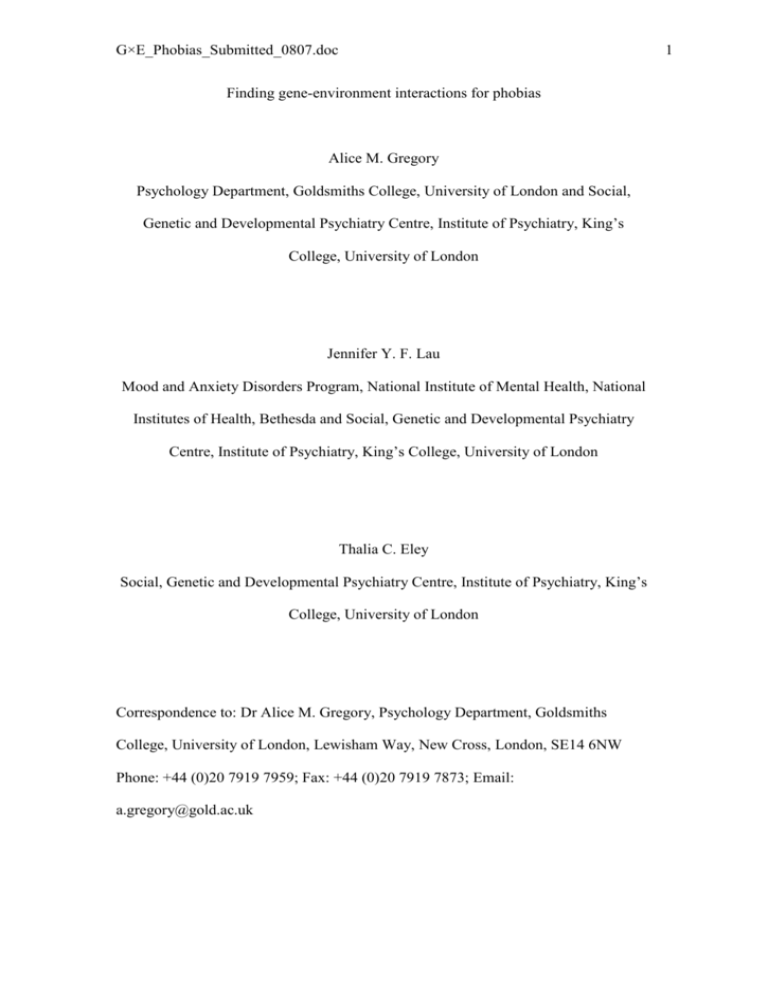
G×E_Phobias_Submitted_0807.doc 1 Finding gene-environment interactions for phobias Alice M. Gregory Psychology Department, Goldsmiths College, University of London and Social, Genetic and Developmental Psychiatry Centre, Institute of Psychiatry, King’s College, University of London Jennifer Y. F. Lau Mood and Anxiety Disorders Program, National Institute of Mental Health, National Institutes of Health, Bethesda and Social, Genetic and Developmental Psychiatry Centre, Institute of Psychiatry, King’s College, University of London Thalia C. Eley Social, Genetic and Developmental Psychiatry Centre, Institute of Psychiatry, King’s College, University of London Correspondence to: Dr Alice M. Gregory, Psychology Department, Goldsmiths College, University of London, Lewisham Way, New Cross, London, SE14 6NW Phone: +44 (0)20 7919 7959; Fax: +44 (0)20 7919 7873; Email: a.gregory@gold.ac.uk G×E_Phobias_Submitted_0807.doc Phobias are common disorders causing a great deal of suffering. Studies of gene-environment interaction (G x E) have revealed much about the complex processes underlying the development of various psychiatric disorders but have told us little about phobias. This article describes what is already known about genetic and environmental influences upon phobias and suggests how this information can be used to optimise the chances of discovering G x Es for phobias. In addition to the careful conceptualisation of new studies, it is suggested that data already collected should be re-analysed in light of increased understanding of processes influencing phobias. Key words: Gene, environment, interaction, phobia, twins 2 G×E_Phobias_Submitted_0807.doc Finding gene-environment interactions for phobias Despite having saved hard for her “trip of a life-time”, a friend recently revealed that she was half-dreading her honeymoon because she knew that her new husband would spend the entire 11 hour flight in a state of complete terror – a result of his lifelong fear of flying. Specific phobias are one of three main types of phobias highlighted in the Fourth Edition of the Diagnostic and Statistical Manual of Mental Disorders (1). The other two are social phobia (characterised by high levels of anxiety resulting from exposure to social or performance situations) and agoraphobia (clinically significant levels of fear or avoidance of certain places or situations which are considered to be difficult or embarrassing from which to escape). Agoraphobia is often co-morbid with panic – and agoraphobics may fear places and situations in which they are concerned that they will not receive help if panicking. Unfortunately, these crippling disorders are common. Indeed, estimates from the National Comorbidity Survey-Replication place anxiety disorders as the most common category of mental illness (21). Of the anxiety disorders, phobias are known to be amongst the most commonly occurring difficulty (10,21) Phobias occur more frequently in females than males, may first appear early in life (especially with regards to specific phobias), and occur concurrently and longitudinally with certain internalising and externalising disorders (10,21,22). In addition to considering phobias in terms of diagnoses, it is possible to examine specific fear symptoms – and considering both approaches may be optimal when designing genetic studies (39). Indeed, focusing upon a single measure of phobias may have limitations, as suggested by research demonstrating that information about fear and phobias assessed at personal interviews shows substantial unreliability (15). 3 G×E_Phobias_Submitted_0807.doc This article addresses issues relevant to the aetiology of phobias. Specifically, there are now rich data estimating and describing genetic and environmental influences upon phobias. However, there have been few investigations of geneenvironment interactions (G x E) in relation to phobias. Given that it is becoming increasingly clear that sensitivity to environmental insults is influenced by genotype and that this information is essential for understanding the complex pathways by which genes influence behaviour (33), this represents a sizeable limitation to knowledge with regards to the aetiology of phobias. In the hope of stimulating research into this area, this article describes what is known about genetic and environmental influences on phobias and discusses issues that need to be considered when designing studies investigating G x E for phobias. Phobias and other anxiety disorders When exploring genetic and environmental influences upon anxiety, researchers often combine different types of anxiety based on the findings that there is strong cross-sectional and longitudinal comorbidity between the different disorders and similarities between anxiety disorders in terms of mental health histories (10). Furthermore, factor analyses suggest that different anxiety disorders share a common factor structure (23). However, there are also reasons to examine phobias separately from other anxiety disorders. For example, factor analyses also suggest that within internalizing disorders it is possible to distinguish between generalized anxiety disorder (GAD) which can be grouped with depression; and a group comprising specific phobias, social phobias, panic and agoraphobia (23,43,44). Furthermore, twin studies suggest that the genetic aetiology of specific phobias may differ from that of other anxiety disorders (13,19). In terms of developmental pathways, whereas most adult anxiety disorders are largely non-specific in terms of their history of anxiety 4 G×E_Phobias_Submitted_0807.doc disorders (they are preceded by a range of juvenile anxiety disorders), adults with specific phobias are unique in having a history of juvenile phobias but not other anxiety disorders (10). This finding is consistent with prior research highlighting specificity within phobias: adolescent simple phobias predicted simple phobias in adulthood, whereas social phobias in adolescence predicted later social phobia (28). Furthermore, selective serotonin reuptake inhibitors (SSRIs) are used to treat various anxiety disorders – but are not typically used in the treatment of specific phobias, due to their limited effectiveness. Hence, studies focusing exclusively upon phobias (as opposed to studies including phobias as part of a general anxiety scale) are the focus of this report. Genetic and environmental influences It has long-since been postulated that both genetic and environmental factors are important in the development of phobias. Indeed, Martin Seligman highlighted in an early paper the importance of environmental influences in the development of specific phobias by pointing out that a neutral stimuli (e.g. a horse) can become aversive when paired with an external negative event (e.g. receiving an electric shock) (35). This early report also pointed out that it is easier to condition phobias towards certain stimuli (e.g. snakes) than others (e.g. flowers) - which may be due to a genetic predisposition to associate certain objects with fear (more recently, see 11 for a genetic study of fear conditioning). While direct conditioning has been the most influential theory of fear acquisition, other pathways are also important. Indeed, Rachman proposed three main pathways to fear conditioning involving direct conditioning; vicarious acquisition and informational/ instructional acquisition (31). Each of these pathways has received support from various sources (e.g. for a test of the informational/ instructional 5 G×E_Phobias_Submitted_0807.doc pathways see 6). Although traditional theories have tended to emphasise the importance of experience in the development of phobias, a fourth, complementary, non-associative route also needs to be acknowledged (for a review see 30). Nonassociative theories of fear acquisition emphasise that evolutionary-relevant fears (such as fears of snakes and heights) can appear with minimal or no learning. Evidence that both genetic and environmental factors are important in explaining individual differences in phobias is provided by data from twin studies. These studies compare similarity between monozygotic twins who are genetic clones, and dizygotic twins who share on average half of their segregating genes (for further discussion of twin methodology see 29). Results of studies have shown that phobias are more likely to co-occur in monozygotic than dizygotic twins. Studies focusing upon children have found significant genetic influence upon fears and specific phobias examined in terms of symptoms (42) and disorders (2,24). Similarly, studies of adult twins have highlighted the importance of genes influencing specific phobias (e.g. 15,17,38), social phobias (e.g. 15,17,38) and agoraphobia (e.g. 15,17,38). In addition to distinguishing genetic and environmental influences, most twin studies also distinguish shared environmental influences (those that make family members alike) and nonshared environmental influences (those that make family members differ). Nonshared environment appears to have a robust influence on phobias (e.g. 2,20,17). However, research has produced mixed results with regards to shared environmental influence. For example, one study of children highlighted shared environmental influence on phobias (24) whereas another did not find this type of influence to be significant (2). Similarly, there have been mixed results from studies of adults – with a study of males revealing possible shared environmental 6 G×E_Phobias_Submitted_0807.doc influence on agoraphobia and social phobia but not specific phobia (17). A further report showed negligible shared environmental influence on panic-phobia in males but a more modest influence on females (20). The distinction between shared and nonshared environmental influences is relevant to studies of G x E. Indeed, most twin analyses do not estimate G x E and if positive interactions between genetic and shared environmental influences are present but ignored they artificially inflate estimates of genetic influence. In contrast, positive interactions between genetic and nonshared environmental influence are estimated as nonshared environmental influence (32). Studies of both children and adults have highlighted differences between the sexes in terms of the magnitude of influences on different types of phobias (e.g. 20,24). Further studies have also revealed that some of the genes influencing phobic disorders may differ between males and females. For example, a study of over 3000 adult twin pairs found that exactly the same set of genes influenced animal fears in both males and females (14). In contrast, for agoraphobia, situational phobia and blood/injury phobia there was some genetic overlap although different genes also influenced these traits in males and females separately. Hence, the impact of sex differences appears to vary across phobia subtype. To add further complexity, sex differences have also been found in the magnitude of influences accounting for stability of symptoms. Specifically, one study found that, for males, genes account for 73% of the stability of panic-phobic symptoms over a mean 14-month period, as compared to 24% for females (20). Genetic and environmental influences clearly differ by phenotype and sex and these variables therefore need to be considered when planning G x E studies for phobias. Twin studies have also increased understanding of comorbidity. For example, a twin study of different phobias in males revealed that genetic risks were partly 7 G×E_Phobias_Submitted_0807.doc common and partly specific across different types of phobias (17). Studies examining the overlap between different types of anxiety have also highlighted an overlap between genes influencing different types of anxiety (for a study of anxiety-related behaviours in pre-school twins see 5), although such studies have also suggested that the aetiology of specific phobias may be largely distinct from that of other anxiety disorders (13,19). In addition to providing information about the co-occurrence of anxiety disorders, studies of comorbidity examine different types of disorders. For example, those with phobias are at increased risk of major depressive disorder (12) and comorbidity between the two types of illness appears to be influenced by genetic and environmental influences to different degrees depending upon the type of phobia being examined in association with depression (18, see also 26). Longitudinal associations between phobias and depression have also been reported and genetic decomposition of this association in a sample of over 600 female twin pairs revealed that genetic influences on depression after 14 years of age reflect liability to symptoms of phobias before the age of 14, whereas shared environmental influences on depression before 14 years of age influenced phobias after the age of 14 (36) highlighting the role of development in the complex links between phobias and depression. Twin studies of co-occurring traits are useful when planning studies of G x E, as strong correlations between the influences (e.g. genes) on different traits (e.g. depression and phobias) suggest that once a specific influence on one trait (e.g. depression) has been identified, this same influence may also be a good candidate to explore in models of G x E with regards to the co-occurring trait (e.g. phobias). Genetic models have also been used to shed light on links between phobias and cognitive dimensions and one study reported a strong genetic correlation between fear of negative evaluation (a cognitive construct central to social phobia) and social 8 G×E_Phobias_Submitted_0807.doc anxiety related personality traits (40). It may be fruitful to measure cognition (in addition to phobias) in G x E models as it is possible that cognitive style mediates some of the genetic risk on phobic symptoms. Measuring cognitions central to phobias may therefore allow testing of theories underlying the development and maintenance of these difficulties. Furthermore, certain central cognitive aspects of phobias may be more directly influenced by genes than the symptoms of phobias themselves. Such ‘endophenotypes’ for phobias need to be proposed and tested empirically (for further discussion of endophenotypes in genetic research see 9). There has been extensive debate concerning the adequacy of the twin methodology. Critics of twin research claim that the assumptions underlying the methodology are unfounded and so estimates provided by studies employing twin methodology are inaccurate. Twin researchers justify assumptions made and point out that this is amongst the best methodologies available whilst emphasising the need for cautious general interpretation of estimates from twin data (see 29 for further discussion of this topic). Although it is beyond the scope of this review to represent this highly charged debate, it is important to mention criticisms which have focused upon phobias. One such criticism concerns generalizability. In order to extrapolate results from twin studies to the non-twin population, it must be assumed that twins are similar to non-twins. However, this is not necessarily the case for phobias – as one study including both twin and sibling pairs revealed higher levels of heritability for panic-phobia when focusing upon twins exclusively than when including non-twins (20). Other studies have emphasised similarities between twins and non-twins however, and the prevalence rate for psychiatric disorders is similar in twins and nontwins (37). Despite criticisms, twin studies have revealed a great deal about genetic and environmental influences on phobias. Together with early conditioning studies 9 G×E_Phobias_Submitted_0807.doc which suggest that phobias may arise from genetic propensities which are expressed following exposure to certain environmental stimuli, twin studies have stimulated hypotheses concerning G x E for phobias. Finding G x Es for phobias The finding from twin studies that environmental factors are influential (albeit to varying degrees) sits well with clinical observations that patients with phobias often report early traumatic experiences associated with their phobias. However, such observations may not demonstrate purely ‘environmental’ influences on phobias as it is known that genes may influence both exposure and sensitivity to environmental insults. Imagine for example that a child has genes associated with high levels of behavioural inhibition. Perhaps these genes influence the way in which the child interacts with unfamiliar animals – and the awkward stroking of a dog may lead to the child being bitten (an example of gene-environment correlation, rGE). Based on the child’s genetic propensity, this environmental trauma may make this child (as compared to certain other children) particularly vulnerable for developing a dog phobia (an example of G x E). There is little evidence of rGE and G x E for phobias. However, one study explored the possibility of a stress-diathesis model for phobias in 7500 twin pairs (16). The authors examined whether phobic individuals who reported higher levels of environmental stress (e.g. experiencing a severe trauma) had a lower genetic loading (i.e. were phobias were less heritable in this sub-group?) as compared to those who reported lower levels of environmental stress (e.g. observing a trauma occurring to another or experiencing a mild trauma). The results did not support the stressdiathesis model and the authors proposed that this is most likely because the model is 10 G×E_Phobias_Submitted_0807.doc not applicable to phobias and instead argue that vulnerability to phobias may be largely innate without the need for environmental experiences. An alternative suggestion of these null results concerns the measure of the environment – which could have been inappropriate. While the authors point out that this explanation is unlikely given the adequate reliability and validity of their assessment of stress – the issue of how best to conceptualise the environment is of central importance when designing studies of G x E. For example, it is important to decide upon the optimum aspect of the environment on which to focus – and there are distinctions between ‘negative life events’ influencing anxiety and depression, with ‘threat’ events associated with anxiety and ‘loss’ events associated with depression (e.g. 7). Additionally, there may be differences between anxiety disorders with regards to environmental influences. For example, while elevated rates of abuse have been reported in individuals with different types of anxiety disorders, two studies suggest that there may be a particularly strong association between abuse and panic as compared to certain other anxiety disorders (34,41). Further still there are likely to be distinctions between different types of phobias in terms of environmental influences. For example, Kenneth Kendler and colleagues identified differences in the mode of acquisition of different types of phobias (16). Whereas experiencing a trauma was identified as the mode of acquisition for 48% of participants with animal fears, it accounted for just 23% of cases of social fears. In addition to consideration of the optimal environmental phenotype to measure in G x E models, the timing of environmental experiences also needs to be considered. First, the impact of certain life events may vary with age. For example, being bitten by a dog may represent a more traumatic experience for a young child who has not yet developed the cognitive capacity to deal with this event, as compared 11 G×E_Phobias_Submitted_0807.doc to an adult. A further consideration concerns latent inhibition which refers to a phenomenon whereby being pre-exposed to a neutral stimulus results in subsequent difficulty when attempting to condition that stimulus to be aversive. This theory would explain increased susceptibility of dog phobia in a bitten child as compared to a bitten adult by pointing to greater neutral exposure to dogs in adults as compared to children. As environmental events associated with phobias may have occurred early in life care needs to be taken when measuring events that have occurred a long time ago. In particular, use of prospective longitudinal data eliminates the need for retrospective reporting, which is notoriously unreliable. Research also suggests that phobias may develop as an acute reaction to an event – and genetic moderation of response to experimental manipulations of the environment (e.g. requesting patients with social phobia to give a public presentation; using novel paradigms to eliciting an acute response in ‘real-time’) is therefore likely to be scientifically important. Ethical considerations in relation to eliciting or inducing stress in participants suggests that animal studies are likely to continue being used in order to establish responses to certain environmental manipulations (e.g. classical conditioning studies of phobias). In addition to environmental explanations for the lack of evidence for G x E for phobias, a further explanation could be that previous studies have not assessed genetic influence appropriately. For example, sample size must be considered in order to ensure appropriate power to identify the interactions being sought. While previous studies employ large sample sizes and are therefore appropriate with regards to this issue (16), these studies have estimated as opposed to measured genetic influence, and the latter approach has obvious advantages. Consequently, in addition to identifying statistical G x E, studies of other phenotypes have begun to examine associations between specific genes and environmental factors (e.g. the short allele of the 5-HTT 12 G×E_Phobias_Submitted_0807.doc promoter polymorphism has been associated with greater sensitivity to life events in the development of depression, 4). When designing studies of G x E for phobias, researchers should capitalise upon what is already known about specific genes linked with phobias in order to select candidate genes to examine in models of G x E. For example, there have been associations between phobias and the val/val genotype of the catechol-O-methyltransterase (COMT) Val158Met polymorphism (25) and with genes involved in thyroid hormone receptor function (27). Candidate genes may also come from other types of studies, such as twin studies of comorbidity – as knowledge of strong genetic overlap between disorders suggests that once a gene has been associated with one disorder it may also be associated with the comorbid disorder. Conclusion Twin studies have been essential in advancing understanding of genetic and environmental influences on phobias - although previous research is limited in that it largely ignores associations between genes and the environment. Studies of G x E inevitably involve measurement of three components: genes; the environment; and phobias. Given developing knowledge of all three, it is increasingly likely that novel studies utilising this knowledge and designed to identify G x E for phobias will succeed. In addition to the careful conceptualisation of new studies designed to find G x Es for phobias, researchers may also benefit from re-examining data which have already been collected. Indeed, distinctions between phobias and other types of anxiety suggest that it may be beneficial to regroup data already collected in order to focus upon: 1) specific types of phobias (rather than anxiety as a whole); 2) environmental factors which have been directly linked to phobias (rather than more general measures of stress); and 3) genes that have been associated with phobias 13 G×E_Phobias_Submitted_0807.doc (rather than more generally with anxiety). This approach is likely to be particularly fruitful in light of continuous growth in knowledge of genes and environmental factors linked to phobias. In order to develop a more comprehensive understanding of phobias, it may also be worthwhile acknowledging other disciplines. Twin studies have already used important information provided by cognitive psychologists to increase understanding of the aetiology of phobias. Furthermore, reviews have stressed the mutual benefit of combining gene-environment interactions and neuroscience in psychiatry (3). For example, based partly on G x E findings that genetic influence on a trait may only appear following a stressful experience, one study explored an association between a specific polymorphism and a brain response, finding that the 5-HTT candidate gene is associated with individual differences in amygdala responsiveness to social anxiety provocation in patients with social phobia (8). In turn, such findings provide inspiration to researchers developing studies of G x E for phobias. 14 G×E_Phobias_Submitted_0807.doc 15 Acknowledgements Thalia C. Eley is funded by a Medical Research Council Career Development Award. The authors thank Megan Crawford, Jessica Holland and Thomas Willis for their feedback on an earlier draft of this manuscript and for their assistance in preparing this article. G×E_Phobias_Submitted_0807.doc Reference List 1. American Psychiatric Association (1994) Diagnostic and statistical manual of mental disorders, 4th edition. American Psychiatric Press, Washington, DC 2. Bolton D, Eley TC, O'Connor TG, Perrin S, Rabe-Hesketh S, Rijsdijk F, Smith P (2006) Prevalence and genetic and environmental influences on anxiety disorders in 6-year-old twins. Psychological Medicine 36:335344 3. Caspi A, Moffitt TE (2006) Opinion - Gene-environment interactions in psychiatry: joining forces with neuroscience. Nature Reviews Neuroscience 7:583-590 4. Caspi A, Sugden K, Moffitt TE, Taylor A, Craig IW, Harrington H, McClay J, Mill J, Martin J, Braithwaite A, Poulton R (2003) Influence of life stress on depression: moderation by a polymorphism in the 5-HTT gene. Science 301:386-389 5. Eley TC, Bolton D, O'Connor TG, Perrin S, Smith P, Plomin R (2003) A twin study of anxiety-related behaviours in pre-school children. Journal of Child Psychology and Psychiatry and Allied Disciplines 44:945-960 6. Field AP, Lawson J (2003) Fear information and the development of fears during childhood: effects on implicit fear responses and behavioural avoidance. Behaviour Research and Therapy 41:1277-1293 16 G×E_Phobias_Submitted_0807.doc 7. Finlay-Jones R, Brown GW (1981) Types of stressful life events and the onset of anxiety and depressive disorders. Psychological Medicine 11:803-815 8. Furmark T, Tillfors M, Garpenstrand H, Marteinsdottir I, Langstrom B, Oreland L, Fredrikson M (2004) Serotonin transporter polymorphism related to amygdala excitability and symptom severity in patients with social phobia. Neuroscience Letters 362:189-192 9. Gottesman II and Gould TD (2003) The endophenotype concept in psychiatry: Etymology and strategic intentions. American Journal of Psychiatry 160:636-645 10. Gregory AM, Caspi A, Moffitt TE, Koenen K, Eley TC, Poulton R (2007) Juvenile mental health histories of adults with anxiety disorders. American Journal of Psychiatry 164:301-308 11. Hettema JM, Annas P, Neale MC, Kendler KS, Fredrikson M (2003) A twin study of the genetics of fear conditioning. Archives of General Psychiatry 60:702-708 12. Hettema JM, Prescott CA, Kendler KS (2003) The effects of anxiety, substance use and conduct disorders on risk of major depressive disorder. Psychological Medicine 33:1423-1432 13. Hettema JM, Prescott CA, Myers JM, Neale MC, Kendler KS (2005) The structure of genetic and environmental risk factors for anxiety disorders in men and women. Archives of General Psychiatry 62:182-189 17 G×E_Phobias_Submitted_0807.doc 14. Kendler KS, Jacobson KC, Myers J, Prescott CA (2002) Sex differences in genetic and environmental risk factors for irrational fears and phobias. Psychological Medicine 32:209-217 15. Kendler KS, Karkowski LM, Prescott CA (1999) Fears and phobias: reliability and heritability. Psychological Medicine 29:539-553 16. Kendler KS, Myers J, Prescott CA (2002) The etiology of phobias - an evaluation of the stress-diathesis model. Archives of General Psychiatry 59:242-248 17. Kendler KS, Myers J, Prescott CA, Neale MC (2001) The genetic epidemiology of irrational fears and phobias in men. Archives of General Psychiatry 58:257-265 18. Kendler KS, Neale MC, Kessler RC, Heath AC, Eaves LJ (1993) Major depression and phobias: the genetic and environmental sources of comorbidity. Psychological Medicine 23:361-371 19. Kendler KS, Prescott CA, Myers J, Neale MC (2003) The structure of genetic and environmental risk factors for common psychiatric and substance use disorders in men and women. Archives of General Psychiatry 60:929-937 20. Kendler KS, Walters EE, Truett KR, Heath AC, Neale MC, Martin NG, Eaves LJ (1995) A twin-family study of self-report symptoms of panic-phobia and Somatization. Behavior Genetics 25:499-515 18 G×E_Phobias_Submitted_0807.doc 21. Kessler RC, Berglund P, Demler O, Jin R, Walters EE (2005) Lifetime prevalence and age-of-onset distributions' of DSM-IV disorders in the national comorbidity survey replication. Archives of General Psychiatry 62:593-602 22. Kessler RC, Chiu WT, Demler O, Walters EE (2005) Prevalence, severity, and comorbidity of 12-month DSM-IV disorders in the National Comorbidity Survey Replication. Archives of General Psychiatry 62:617-627 23. Krueger RF (1999) The structure of common mental disorders. Archives of General Psychiatry 56:921-926 24. Lichtenstein P and Annas P (2000) Heritability and prevalence of specific fears and phobia in childhood. Journal of Child Psychology & Psychiatry 41:927-937 25. McGrath M, Kawachi I, Ascherio A, Colditz GA, Hunter DJ, De Vivo I (2004) Association between catechol-O-methyltransferase and phobic anxiety. American Journal of Psychiatry 161:1703-1705 26. Nelson EC, Grant JD, Bucholz KK, Glowinski A, Madden PAF, Reich W, Heath AC (2000) Social phobia in population-based female adolescent twin sample: co-morbidity and associated suicide-related symptoms. Psychological Medicine 30:797-804 27. Philibert R, Caspers K, Langbehn D, Troughton EP, Yucuis R, Sandhu HK, Cadoret RJ (2002) The association of a HOPA polymorphism with major depression and phobia. Comprehensive Psychiatry 43:404-410 19 G×E_Phobias_Submitted_0807.doc 28. Pine DS, Cohen P, Gurley D, Brook J, Ma YJ (1998) The risk for earlyadulthood anxiety and depressive disorders in adolescents with anxiety and depressive disorders. Archives of General Psychiatry 55:56-64 29. Plomin R, DeFries JC, McClearn GE, McGuffin P (2001) Behavioral Genetics 4th Edition, Worth Publishers, New York 30. Poulton R, Menzies RG (2002) Non-associative fear acquisition: a review of the evidence from retrospective and longitudinal research. Behaviour Research and Therapy 40:127-149 31. Rachman SJ (1978) Fear and Courage, WH Freeman & Co, San Francisco 32. Rijsdijk FV and Sham PC (2002) Analytic approaches to twin data using structural equation models. Briefings in bioinformatics 3:119-133 33. Rutter M (2006) Gene-environment interplay in Genes and Behaviour, Blackwell, Oxford: 178-210 34. Safren SA, Gershuny BS, Marzol P, Otto MW, Pollack MH (2002) History of childhood abuse in panic disorder, social phobia, and generalized anxiety disorder. Journal of Nervous and Mental Disease 190:453-456 35. Seligman ME (1971) Phobias and preparedness. Behavior Therapy 2:307-320 36. Silberg JL, Rutter M, Eaves L (2001) Genetic and environmental influences on the temporal association between earlier anxiety and later depression in girls. Biological Psychiatry 49:1040-1049 20 G×E_Phobias_Submitted_0807.doc 37. Simonoff E, Pickles A, Meyer J, Silberg JL, Maes H, Loeber R, Rutter M, Hewitt JK, Eaves LJ (1997) The Virginia twin study of adolescent behavioral development. Influences of age, sex, and impairment on rates of disorder. Archives of General Psychiatry 54:801-808 38. Skre I, Onstad S, Torgersen S, Lygren S, Kringlen E (2000) The heritability of common phobic fear: a twin study of a clinical sample. Journal of Anxiety Disorders 14:549-562 39. Smoller JW, Tsuang MT (1998) Panic and phobic anxiety: defining phenotypes for genetic studies. American Journal of Psychiatry 155:1152-1162 40. Stein MB, Jang KL, Livesley WJ (2002) Heritability of social anxiety-related concerns and personality characteristics: a twin study. Journal of Nervous and Mental Disease 190:219-224 41. Stein MB, Walker JR, Anderson G, Hazen AL, Ross CA, Eldridge G, Forde DR (1996) Childhood physical and sexual abuse in patients with anxiety disorders and in a community sample. American Journal of Psychiatry 153:275-277 42. Stevenson J, Batten N, Cherner M (1992) Fears and fearfulness in children and adolescents: a genetic analysis of twin data. Journal of Child Psychology and Psychiatry 33:977-985 43. Vollebergh WAM, Iedema J, Bijl RV, de Graaf R, Smit F, Ormel J (2001) The structure and stability of common mental disorders - The NEMESIS study. Archives of General Psychiatry 58:597-603 21 G×E_Phobias_Submitted_0807.doc 44. Watson D (2005) Rethinking the mood and anxiety disorders: a quantitative hierarchical model for DSM-V. Journal of Abnormal Psychology 114:522-536 22
